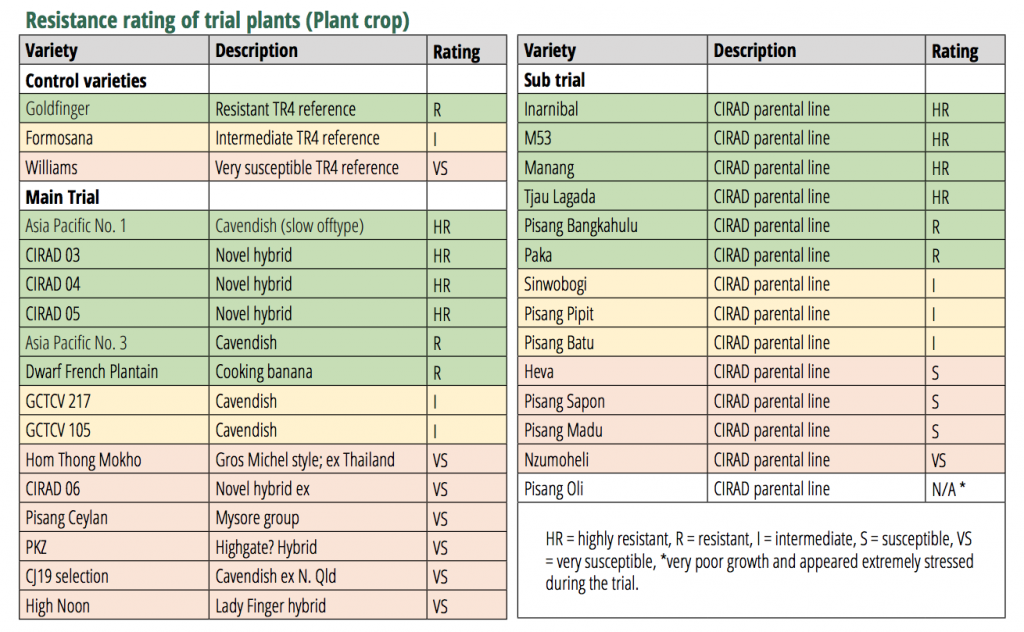
The quest for a commercially acceptable variety resistant to TR4 continues at the Coastal Plains Research Farm in the Northern Territory.
The latest results from the program have been promising with four Cavendish selections showing resistance as good as or better than Formosana (GCTCV 218) in the plant crop.
By Sharl Mintoff, Samantha Cullen, Chris Kelly, Maxine Piggott
Northern Territory Department of Primary Industry and Resources, Darwin, NT
In December 2018, 32 banana varieties (comprising of three control reference varieties and 29 test varieties) were planted at Coastal Plains Research Farm in the Northern Territory to assess their resistance or susceptibility to Panama disease Tropical Race 4 (TR4).
This planting and assessment is part of the ‘Improved plant protection for the banana industry’ project (BA16001).
Data collection has been completed for the plant crop and includes the presence of external and internal symptoms of TR4, the amount of crop loss due to the disease and agronomic measurement of the surviving plants.
Currently most of the surviving varieties have produced their first ratoon bunches with harvest expected over the coming months.
The trial itself was split into two smaller trials, to account for the different plant numbers that were available at the time, named the “Main trial” and the “Sub-trial”.
The Main trial consists of Cavendish lines from Taiwan and a selection from North Queensland, CIRAD hybrid lines, and various other selections.
The Sub-trial consists of the parental lines used in the CIRAD breeding program, to help inform selection of future breeding crosses for TR4 resistance.
The information presented in this article is for the disease screening results of the plant crop only.
METHODS
All plants in the trial were artificially inoculated with TR4 colonised millet.
Three reference varieties acted as control treatments for comparison, Williams – Very Susceptible; Formosana (GCTCV 218) – Intermediate; and Goldfinger (FHIA-01) – Resistant, as their reactions to TR4 are well known and act as a reference point for the other test varieties.
Once external symptoms became apparent in the susceptible Williams control or another susceptible variety, fortnightly disease assessments were conducted which noted the appearance of external disease symptoms and internal symptoms at plant death or harvest.
Disease performances have been categorised based on the criteria which follows.
The categories and their definition are a little different to those reported for the previous TR4 screening trial in BA10020 owing to higher disease inoculum pressure encountered in the current trial.
Highly Resistant (HR) – No disease symptoms were observed within the crop cycle and may not show symptoms under high inoculum pressures.
Resistant (R) – Plants normally show no signs of infection in the presence of the pathogen. However, under high inoculum pressures low amounts of symptoms or losses may occur.
Intermediate (I) – Plants which can withstand some infection and suffer low losses under natural infestation conditions, with most completing their crop cycle. However, its susceptibility or resistance can be highly dependent on the inoculum pressure already present. With the appropriate crop management or environment to lower the inoculum levels, these should be commercially viable.
Susceptible (S) – more than 50% of plants show symptoms and/or killed due to pathogen infection. Very susceptible (VS) – Majority of plants showed severe symptoms, most of which died due to TR4 (more than 70%).
RESULTS
Highly resistant
Eight varieties fell into this category and have not shown any disease symptoms within their plant crop and include three CIRAD hybrids (CIRAD 03, 04 and 05), Asia Pacific No.1 (slow offtype) and CIRAD parental lines (Inarnibal, M53, Manang and Tjau Lagada) (Figure 1).
Resistant
Under this category, these plants are normally resistant to the disease yet under high inoculum pressures can exhibit low proportions of symptoms, which was the case with the resistant control Goldfinger. Other varieties that fell into this category were Dwarf French Plantain, Asia Pacific No.3, and the breeding lines Pisang Bangkahulu and Paka.
Intermediate
Varieties in this category possess some resistance to tolerate infection and maintain minimal losses compared to susceptible varieties, however once the inoculum pressure of the disease increases the plant’s susceptibility will also increase. An example of this is Formosana (GCTCV 218), which is used as the Intermediate control, as trials in Taiwan and the Philippines show low crop losses in the presence of the pathogen. Varieties within this trial that fell into this category are GCTCV 105, GCTCV 217, and the breeding lines Sinwobogi, Pisang Pipit and Pisang Batu.
Susceptible
Varieties that fall into this category showed a higher disease incidence compared to the Intermediate category and include the breeding lines: Heva and Pisang Sapon.
Very susceptible
Plants of this category suffered from severe disease symptoms and high mortality rates due to infection by TR4. These varieties included the Cavendish varieties Williams (very susceptible control) and the CJ19 selection, Hom Thong Mokho, CIRAD 06, Pisang Ceylan, PKZ, High Noon and the breeding line Nzumoheli (Figure 2).
CONCLUSION
Within the plant crop cycle, 11 of the tested varieties were rated as susceptible or worse. Whereas, 12 of the tested varieties were rated as resistant or highly resistant.
Encouragingly the two Asia Pacific Cavendish varieties, three of the four CIRAD hybrids and some CIRAD parental lines have shown strong resistance within their plant crop cycles. Currently, assessments of the first ratoon crop are underway and time will tell whether or not the resistance ratings of these varieties will hold into the next crop cycle.
This trial is expected to be completed by the end of the year. That will coincide with the commencement of the next screening trial including some varieties recently released from quarantine.
